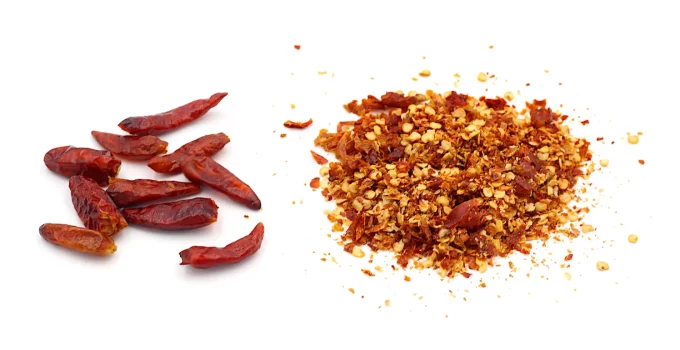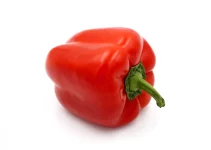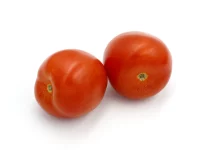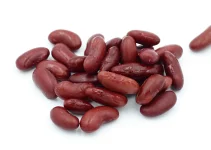You might be wondering, is there a point comparing chili flakes vs red pepper flakes? Aren’t these two spicy delights the same thing?
If you thought they are the same thing, you aren’t that further from the truth. They’re not identical but I consider that we can use both terms interchangeably.
Moreover, in some cases, you won’t find the tiny red pieces with lots of seeds under the name of either chili flakes or red pepper flakes. Some manufacturers will label theirs as crushed red pepper.
I would actually go as far as to say that crushed red pepper might be the most popular name of the three. Crushed chili is another name that you might come across. Or ground chili pepper.
Plus, if you don’t like the seeds aspect, you can buy chili powder. It will blend with the rest of the ingredients perfectly, you’ll see no sign of seeds or tiny red pieces of dried chili.
We can also use chili flakes or red pepper flakes to make the spiciest instant ramen noodles.
Table of Contents
Chili Flakes vs Red Pepper Flakes: The Main Difference
Frankly, the difference is a bit technical, to put it that way.
For me, chili flakes and red pepper flakes are absolutely the same thing. After all, their main purpose is to bring all the heat we want to our favorite foods.
I love fresh chili peppers in all their colors and shapes and different spicy levels but I also love the convenience of adding red pepper flakes to my food just as much.
For some, they might be well acquainted with the jar of chili flakes they find on every table at pizza parlors. That’s certainly one way to elevate something that already tastes delicious all on its own. That might have been some people’s first introduction to using chili flakes on their foods but it won’t be the last.
We can add chili flakes or red pepper flakes to pretty much all our savory dishes that we wish to be spicy: soups, salads, on pizza, to pasta dishes, to stews, noodle dishes, rice dishes, stir fries, in spice mixes for dry rubs, marinades, dressings, sauces, etc. The list is endless.
We can also add these flakes to our pickling mixes, alongside bay leaves, mustard seeds, black peppercorns, dill seeds/dill weed, etc.
However, since I said that they aren’t actually identical, let’s see what makes chili flakes different from red pepper flakes.
In order to understand the main difference in our chili flakes vs red pepper flakes comparison, we need to establish what these two spices are.
What are chili flakes?
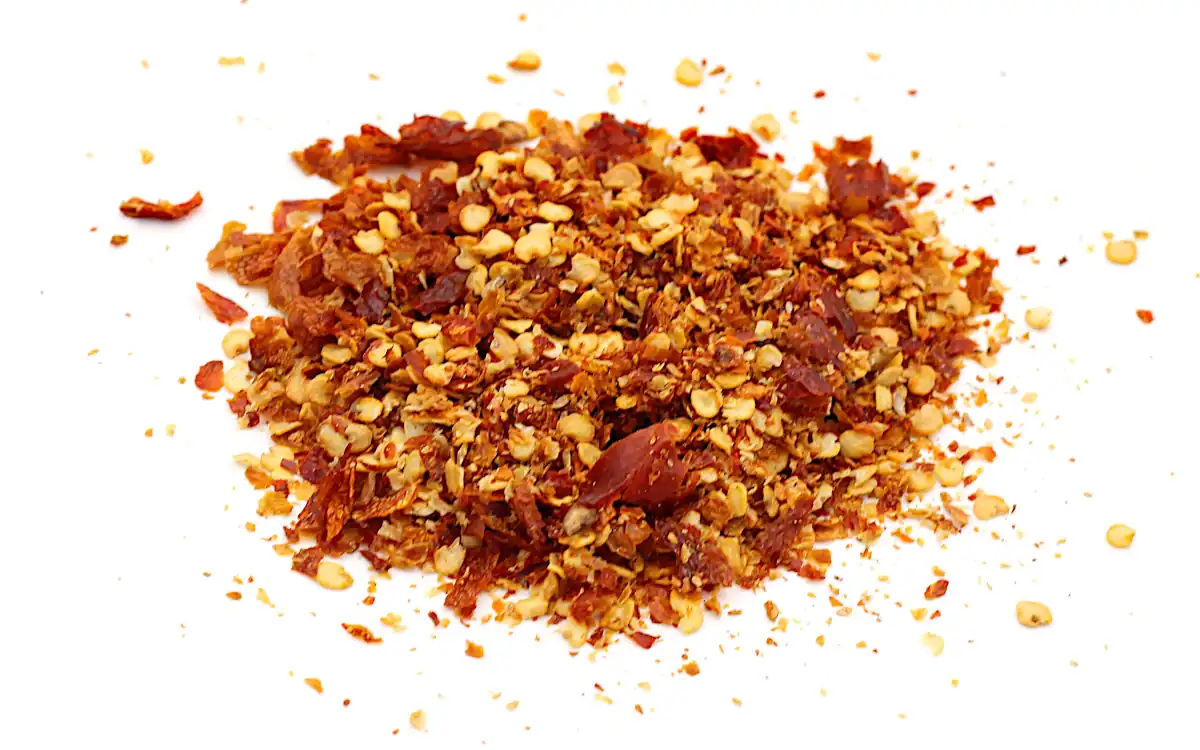
If we want to get truly technical, we would say that chili flakes are made from a single type of pepper. They should have that pepper’s flavor.
Chili flakes are obtained by grinding or crushing dried red peppers.
Since, traditionally, only a type of dried pepper is grounded or crushed in order to obtain the chili flakes, you might find them under names such as Chipotle flakes, Aleppo pepper flakes, Sichuan chili flakes, Urfa pepper (Urfa biber flakes), etc.
Some will be sold with seeds and all, while other crushed pepper will be sold sans seeds.
The distinction is that you know exactly which dried red peppers have been grounded or crushed.
It might be an interesting fact to know for those who are looking for a distinct chili variety to flavor their foods.
You can also approximate just how hot the chili flakes are going to be, based on which chili variety they’re made from.
What are red pepper flakes?
Red pepper flakes are made from a mix of peppers. Thus, we don’t know exactly which dried red pepper varieties were used to make the pepper flakes.
Frankly, I don’t really care which red pepper varieties were used in making all the red pepper flakes that I buy because I’m only interested in the fact that they’re all delicious and spicy.
The mix of peppers that are used for making red pepper flakes depends from manufacturer to manufacturer.
The most popular variety for making red pepper flakes is the cayenne pepper.
Still, we could also get a mix of Fresno, Anaheim, bell, jalapeno, etc. In most cases, cayenne pepper will be the predominant one.
Under ingredients, manufacturers usually write just chili pepper or organic chili pepper, if you buy organic crushed red pepper.
Chili Flakes vs Red Pepper Flakes: Similarities
We saw which is the minor difference between the two. We can certainly treat these two spices/condiments as being the same thing.
Since we can view them as one and the same, let’s talk about similarities.
Similar appearance
First of all, if I remove both chili flakes and red pepper flakes from their respective packages, we wouldn’t be able to tell which is which.
The appearance of both is absolutely identical. We get small pieces of red peppers and lots of seeds. The seeds are the most wonderful thing in this mix because they are the ones that give that spiciness that all people who love eating spicy food crave.
However, I should also mention that you might come across chili flakes that include no seeds. In that case, the identical appearance is no longer valid.
It depends on what the stores in your area sell so I thought I should mention both.
Why we use chili flakes, red pepper flakes and crushed red pepper
Besides looking identical, we also get another big similarity: the purpose for which they’re being used in dishes.
The main purpose of chili flakes and red pepper flakes is to make our dishes spicy, as hot as we want them to be.
If your family enjoys different spicy levels, with some none at all, then you should skip on adding fresh chilies to your recipe, even if the recipe calls for fresh chilies being chopped and added to the rest of the ingredients.
What you can do instead is to add a jar of flakes to the table so that everyone can add a few teaspoons to the dish if that’s what they prefer. And those who can’t handle spicy food will be equally happy.
Thus, one important thing I wanted to mention in this chili flakes vs red pepper flakes debate is that they both serve as substitutes for fresh chilies.
It’s certainly more convenient to buy a big bag or jar of either chili flakes, red pepper flakes or crushed pepper than to always go and buy fresh chilies whenever we want to make a dish.
How Hot Are These Crushed Chili Pepper Products?
In order to find how hot chili flakes are, you should check out where the chili variety written on the package lands on the Scoville Scale. Since chili flakes are only made from one variety, it’s pretty easy to find out.
For example, if you bought Chipotle flakes, you can expect a range of 2,500 to 8,000 SHU. They’re in the same range as jalapenos, Chipotle flakes will be fantastic for those who are into medium to low levels of spiciness, like myself.
Aleppo flakes can be a bit spicier if we consider that the Aleppo pepper registers about 10,000 SHU. These are also a must-try.
If you want some seriously hot chili flakes, you’ll be happy to know that Urfa biber rates at 50,000-80,000 SHU.
That’s at least 10 times hotter than Chipotle flakes or jalapenos. Urfa flakes are absolutely not for me, although I love their unique, darker coloring. Plus, they’re also described as having a smoky, raisin-like taste, which sounds amazing. But I know that I can’t handle them so I’m staying away.
Since red pepper flakes are made from a mix of dried red peppers, we can only approximate where they would land on the Scoville scale.
The thing that helps is knowing that cayenne pepper is the preponderant chili variety in the mix. Red pepper flakes land within the 30,000-50,000 SHU, which means that they’re more gentle than Urfa biber.
Can we use chili flakes and red pepper flakes interchangeably?
If you ask yourself if chili flakes can be used as a substitute for red pepper flakes and vice versa, the answer is yes.
The same goes if you only find this spice/condiment under the name crushed pepper, crushed chili, crushed red pepper or ground chili pepper.
If your local stores only carry a few products and they all are named crushed pepper, then that’s what we should get.
You’ll get a mix of crushed dried chili varieties. The predominant variety in the mix will be cayenne-type peppers so you should expect quite a lot of heat from the mix. We’ve talked about that above.
Should you buy chili flakes, red pepper flakes or stick to fresh chilies?
If you live in a place that has an extended variety or chili flakes, then you can choose the variety that you’re going to be cooking with or add to your cooked dishes.
You could buy Chipotle flakes, Aleppo pepper flakes, Sichuan chili flakes or Urfa pepper flakes, to give you a few examples.
In that case, you know exactly which variety you’re getting, how spicy you might expect it to be, and which will be the predominant flavor for the crushed peppers.
Moreover, some bags will contain the seeds, while others will not. That’s another thing we can choose, while red pepper flakes always contain seeds.
You can buy red pepper flakes if that’s the only thing you can find where you live.
Well, if you don’t like either option, you can always buy chili powders, hot paprika, hot sauces, canned chilies, pickled chilies or just stick to using fresh chili.
For example, if you get a pepperoncini hot sauce or pickled pepperoncini, it will barely have any heat but it will have a wonderful flavor. The same goes for banana peppers.
The final choice also depends on how much heat you enjoy in your dishes because we can definitely choose from so many products, for those lucky enough to have access to a multitude of options.
Plus, you should choose the option that is the most comfortable for your budget. Some chili flakes or red pepper flakes can be expensive, while others will be quite cheap.
In the end, what we’ve learned from our chili flakes vs red pepper flakes comparison is that there can be a difference between them, especially in stores that carry a wide variety of crushed chilies, while at the same time we can also treat the two as being the same product.

